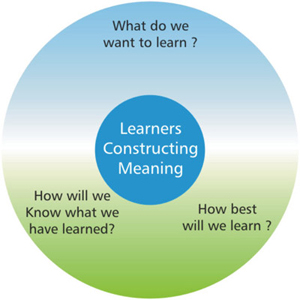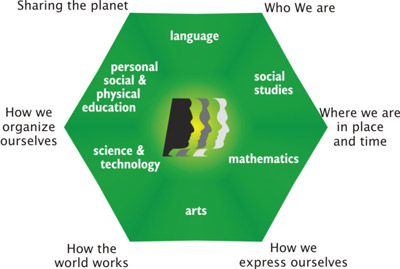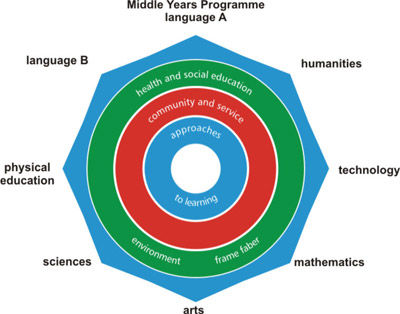Curriculam
The Primary Years Programme Student Profile : The philosophy of the Primary Years Programme, as it directly affects the child, is expressed in a series of desired attributes and traits that characterize students with a national and an international perspective. Taken together, they create a profile of PYP students.
TRAITS
• Inquirers
• Thinkers
• Communications
• Risk takers
• Knowledgeable
• Principled
• Caring
• Open – minded

The Primary Years Programme offers a comprehensive approach to teaching and learning. It provides a complete curriculum model which incorporates guidelines on what students should learn, as well as guidelines teaching methodologies and assessment strategies. This model is expressed through three interrelated questions shown in this diagram.
The written curriculum
What do we want to learn ?
The written curriculum incorporates five essential elements :
CONCEPTS
SKILLS
ATTITUDES
ACTION
KNOWLEDGE
The first four - concepts, skill, attitudes and actions are relevant in and across all subject areas and provide the framework for structured and purposeful inquiry. They can have different applications and interpretations, depending on the subject area. The fifth element is knowledge, which is considered to be a holistic understanding of ideas, not merely the acquisition of facts and skill.

The Curriculum Model
At the heart of the Primary Years Programmes Philosophy is a commitment to structured inquiry as the leading vehicle for learning. Six trans disciplinary themes provide the framework for the explanation of knowledge. Teacher and students are guided by these themes as they design curriculum units for exploration and study. Students explore subject areas through these themes. Often in ways that transcend conventional subject boundaries. In the process, they develop an understanding of important concepts, acquire essential skills and knowledge, develop particular attitudes and learn to take socially responsible action.
• PRIMARY YEARS PROGRAMME
• UNIQUE
• CHARACTERISTICS
• MIDDLE YEARS PROGRAMME
• HOLISTIC LEARNING
The middle Years Programme (MYP) offers an approach to teaching and learning that embraces yet transcends the focus on traditional school subjects. While insisting upon thorough study of the various disciplines, the MYP accentuates the interrelatedness of them and so advances a holistic view of learning. This perspective asks the student to consider issues and problems in their widest scope and to realize that good solutions often draw upon insights one has acquired from many sources. This means helping students recognize relationships between school subjects and the world outside, and learn to combine relevant knowledge, experience and critical thinking to solve authentic problems.
Areas of interaction
Five broad areas known as the areas of interaction give the MYP curriculum its distinctive core and reflect the programme's focus on students intellectual and social development. These are not academic subject like the specific disciplines but rather are common perspectives embedded within and visible across academic subjects. They provide a framework of learning, allowing connections among the subjects themselves.
The middle Years Programme (MYP) offers an approach to teaching and learning that embraces yet transcends the focus on traditional school subjects. While insisting upon thorough study of the various disciplines, the MYP accentuates the interrelatedness of them and so advances a holistic view of learning. This perspective asks the student to consider issues and problems in their widest scope and to realize that good solutions often draw upon insights one has acquired from many sources. This means helping students recognize relationships between school subjects and the world outside, and learn to combine relevant knowledge, experience and critical thinking to solve authentic problems.
The Middle Year Programme
The Middle Year Programme curriculum model is displayed in the shape of an octagon with eight academic areas or subject groups surrounding the areas of interaction. The emphasis is on the fluidity of the system and the interrelatedness of the subjects. Aspects of the areas of interaction are addressed naturally within the distinct disciplines.
Taken as a while, the curriculum provides a balanced education that will equip young people for effective participation in the modern world.

